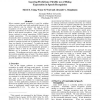Free Online Productivity Tools
i2Speak
i2Symbol
i2OCR
iTex2Img
iWeb2Print
iWeb2Shot
i2Type
iPdf2Split
iPdf2Merge
i2Bopomofo
i2Arabic
i2Style
i2Image
i2PDF
iLatex2Rtf
Sci2ools
139
click to vote
IJCAI
1989
1989
Layering Predictions: Flexible Use of Dialog Expectation in Speech Recognition
entional user behavior, we need a principled mannerAbstract for relaxing contextual constraints when they are violated.When computer speech recognition is used for problem In order to do this, we organize constraints into sets that aresolving or any plan based task, predictable features of the successively more restrictive, called "layers". When someuser’s behavior may be inferred and used to aid the constraints are violated, we use the non-violated constraintsrecognition of the speech input. The MINDS system from a less restrictive layer to reduce search space.generates expectations of what will be said next and uses Additionally, the flexible use of predictions allows us tothem to assist speech recognition. Since a user does not derive constraints from less reliable knowledge sources.always conform to system expectations, MINDS handles Users that behave consistent with the dynamically derivedviolated expectations. We use pragmatic knowledge to expectations can benefit gre...
| Added | 07 Nov 2010 |
| Updated | 07 Nov 2010 |
| Type | Conference |
| Year | 1989 |
| Where | IJCAI |
| Authors | Sheryl R. Young, Wayne H. Ward, Alexander G. Hauptmann |
Comments (0)

